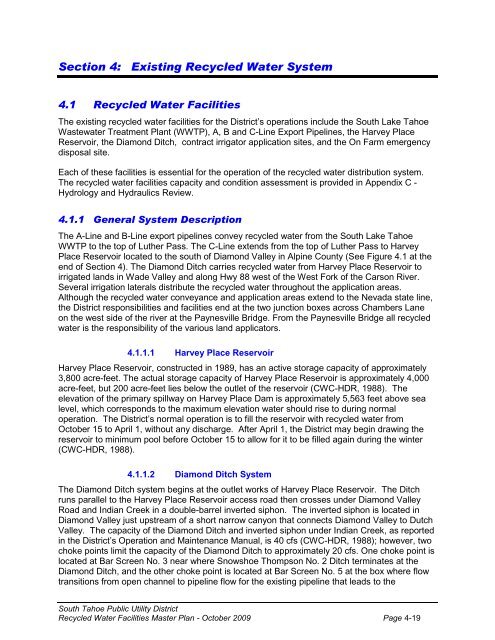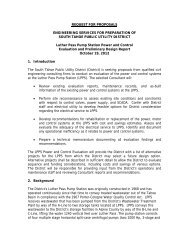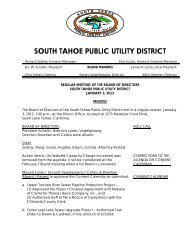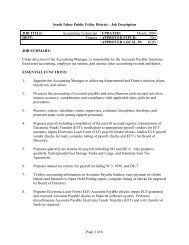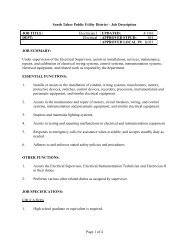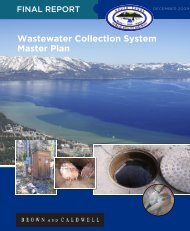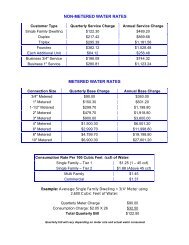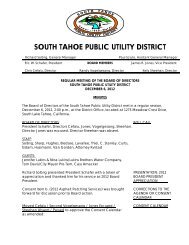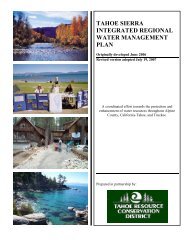October 2009 - South Tahoe Public Utility District
October 2009 - South Tahoe Public Utility District
October 2009 - South Tahoe Public Utility District
You also want an ePaper? Increase the reach of your titles
YUMPU automatically turns print PDFs into web optimized ePapers that Google loves.
Section 4: Existing Recycled Water System<br />
4.1 Recycled Water Facilities<br />
The existing recycled water facilities for the <strong>District</strong>‟s operations include the <strong>South</strong> Lake <strong>Tahoe</strong><br />
Wastewater Treatment Plant (WWTP), A, B and C-Line Export Pipelines, the Harvey Place<br />
Reservoir, the Diamond Ditch, contract irrigator application sites, and the On Farm emergency<br />
disposal site.<br />
Each of these facilities is essential for the operation of the recycled water distribution system.<br />
The recycled water facilities capacity and condition assessment is provided in Appendix C -<br />
Hydrology and Hydraulics Review.<br />
4.1.1 General System Description<br />
The A-Line and B-Line export pipelines convey recycled water from the <strong>South</strong> Lake <strong>Tahoe</strong><br />
WWTP to the top of Luther Pass. The C-Line extends from the top of Luther Pass to Harvey<br />
Place Reservoir located to the south of Diamond Valley in Alpine County (See Figure 4.1 at the<br />
end of Section 4). The Diamond Ditch carries recycled water from Harvey Place Reservoir to<br />
irrigated lands in Wade Valley and along Hwy 88 west of the West Fork of the Carson River.<br />
Several irrigation laterals distribute the recycled water throughout the application areas.<br />
Although the recycled water conveyance and application areas extend to the Nevada state line,<br />
the <strong>District</strong> responsibilities and facilities end at the two junction boxes across Chambers Lane<br />
on the west side of the river at the Paynesville Bridge. From the Paynesville Bridge all recycled<br />
water is the responsibility of the various land applicators.<br />
4.1.1.1 Harvey Place Reservoir<br />
Harvey Place Reservoir, constructed in 1989, has an active storage capacity of approximately<br />
3,800 acre-feet. The actual storage capacity of Harvey Place Reservoir is approximately 4,000<br />
acre-feet, but 200 acre-feet lies below the outlet of the reservoir (CWC-HDR, 1988). The<br />
elevation of the primary spillway on Harvey Place Dam is approximately 5,563 feet above sea<br />
level, which corresponds to the maximum elevation water should rise to during normal<br />
operation. The <strong>District</strong>‟s normal operation is to fill the reservoir with recycled water from<br />
<strong>October</strong> 15 to April 1, without any discharge. After April 1, the <strong>District</strong> may begin drawing the<br />
reservoir to minimum pool before <strong>October</strong> 15 to allow for it to be filled again during the winter<br />
(CWC-HDR, 1988).<br />
4.1.1.2 Diamond Ditch System<br />
The Diamond Ditch system begins at the outlet works of Harvey Place Reservoir. The Ditch<br />
runs parallel to the Harvey Place Reservoir access road then crosses under Diamond Valley<br />
Road and Indian Creek in a double-barrel inverted siphon. The inverted siphon is located in<br />
Diamond Valley just upstream of a short narrow canyon that connects Diamond Valley to Dutch<br />
Valley. The capacity of the Diamond Ditch and inverted siphon under Indian Creek, as reported<br />
in the <strong>District</strong>‟s Operation and Maintenance Manual, is 40 cfs (CWC-HDR, 1988); however, two<br />
choke points limit the capacity of the Diamond Ditch to approximately 20 cfs. One choke point is<br />
located at Bar Screen No. 3 near where Snowshoe Thompson No. 2 Ditch terminates at the<br />
Diamond Ditch, and the other choke point is located at Bar Screen No. 5 at the box where flow<br />
transitions from open channel to pipeline flow for the existing pipeline that leads to the<br />
<strong>South</strong> <strong>Tahoe</strong> <strong>Public</strong> <strong>Utility</strong> <strong>District</strong><br />
Recycled Water Facilities Master Plan - <strong>October</strong> <strong>2009</strong> Page 4-19


